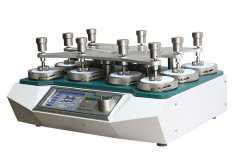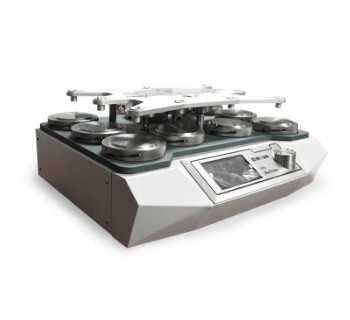Working Principle and Standards of the Martindale Abrasion Tester
The Martindale Abrasion Tester (Martindale method) is used to test the abrasion resistance and apparent pilling properties of woven fabrics, knitted fabrics, nonwovens, decorative materials, and coated fabrics.
Working Principle
The fabric to be tested is mounted in the upper specimen holder and rubbed against an abrasive material mounted on an abrasive table. The friction trace is a Lissajous pattern (a key feature of the Martindale method). According to the test requirements, after a specified abrasion period, the fabric is removed and the abrasion resistance index is calculated or visually assessed to assess the pilling and fuzzing levels.
Key Parameters and Pitfalls to Avoid
There are two key parameters: the number of abrasions required until the fabric shows signs of damage, pilling, or light transmission, which represents its abrasion resistance rating; and the pressure control, which varies depending on the fabric. For example, 9 kPa is common for clothing fabrics, while 12 kPa is required for furniture fabrics.
Purchasing Pitfalls to Avoid:
1. Abrasive Head Stability: This is the area most prone to problems. Low-quality instruments can experience deflection in the grinding head during rotation, leading to excessive localized wear on the specimen and completely inaccurate data. Yihan uses dual-axis precision bearings. During my 72-hour continuous testing, the grinding head deflection was less than 0.1mm, and the measured data compared to SGS laboratory data showed an error of less than 3%.
2. Automatic shutdown sensitivity: Manually monitoring wear is labor-intensive; a good instrument automatically detects damage and shuts down. Many instruments on the market are "too sensitive," stopping at the slightest fuzzing, or "too slow," continuing to operate even after wear.
3. Sample fixture design: Improper specimen mounting can render testing ineffective. Some fixtures can easily deform the fabric during mounting or become loose during testing. It's important to select an instrument that is compatible with multiple standards, such as GB/T 21196. ISO 12947. and ASTM D4966. Otherwise, if the client requires testing according to international standards, you'll have to purchase new equipment.

Procedure
1. Sample Preparation
In a standard environment, lay the sample flat for a period of time, without stretching, according to various standards. Examples include 24 hours (GB/T 4802.2-1997) and 16 hours (EN ISO 12947-4:1998).
2. Specimen Selection
Cut samples from different areas of the doorcloth. The samples must be representative. For fancy fabrics, the samples should include all the different textures and colors present on the surface.
3. Remove the load and load shaft from the testing machine.
4. Remove the top plate and test fixture.
5. Sample Assembly
Loosen the retaining ring on the test fixture, remove the sample pressure plate, and place the sample in the base of the test fixture. For fabrics weighing 500 g/m² or less, place a piece of polyester foam between the sample and the metal plug of the sample holder. For fabrics weighing more than 500 g/m² or composite fabrics, the polyester foam insert is not necessary. The specimen in each specimen holder should be subjected to the same tension.
6. Wool Felt and Rubbing Cloth Device
Place the felt and abrasive on the grinding table. Place a weight on the abrasive. Install the pressure ring and tighten the nut to secure the abrasive to the grinding table.
7. Place the grinding head on the abrasive and apply pressure.
8. Place the test fixture with the specimen face down on the base fixture. Align the circular groove of the test fixture with the load shaft so that the load shaft fits into the circular groove of the test fixture.
9. Set the number of times according to the standard, turn on the switch, and the test will begin. The test will automatically stop after the set number of times is reached.
10. Remove the sample and compare it with the standard sample in the rating box.
Comparison of Martindale Abrasion Tester Standards
International Standards
ISO 12947.2-1998 "Textiles — Determination of the abrasion resistance of fabrics by the Martindale method — Part 2: Determination of specimen damage";
ISO 12947.3-1998 "Textiles — Determination of the abrasion resistance of fabrics by the Martindale method — Part 3: Determination of mass loss";
ISO 12947-4-1998 "Textiles — Determination of the abrasion resistance of fabrics by the Martindale method — Part 4: Evaluation of changes in appearance."
American Society for Materials (ASTM) Standards
EU Standards
ENISO 12947-2:1998 "Textiles – Determination of the abrasion resistance of fabrics by the Martindale method – Part 2: Determination of damage to the test specimen";
ENISO 12947-3:1998 "Textiles – Determination of the abrasion resistance of fabrics by the Martindale method – Part 3: Determination of mass loss";
ENISO 12947-4:1998 "Textiles – Determination of the abrasion resistance of fabrics by the Martindale method – Part 4: Evaluation of changes in appearance."
German Institute for Standardization (DIN) Standards
DINEN ISO 12947-2-2007 "Textiles. Determination of the abrasion resistance of fibers by the Martindale method. Part 2: Determination of test damage"
DINEN ISO 12947-3-2007 "Textiles. Determination of the abrasion resistance of fibers by the Martindale method. Part 3: Determination of mass loss"
DINEN ISO 12947-7-2007 "Textiles. Determination of the abrasion resistance of fabrics by the Martindale method. Part 4: Evaluation of changes in appearance."
British Standards Institution (BS) Standards
BS ISO 12947.2-1998 "Textiles – Determination of the abrasion resistance of fabrics by the Martindale method – Part 2: Determination of specimen damage";
BS ISO 12947.3-1998 "Textiles – Determination of the abrasion resistance of fabrics by the Martindale method – Part 3: Determination of mass loss";
BSEN ISO 12947-4-1999 "Determination of the abrasion resistance of textile fabrics by the Martindale method – Part 4: Evaluation of changes in appearance."
Chinese National Standards
GB/T21196.2-2007 "Textiles - Determination of the abrasion resistance of fabrics by the Martindale method - Part 2: Determination of specimen damage";
GB/T21196.3-2007 "Textiles - Determination of the abrasion resistance of fabrics by the Martindale method - Part 3: Determination of mass loss";
GB/T21196.4-2007 "Textiles - Determination of the abrasion resistance of fabrics by the Martindale method - Part 4: Evaluation of appearance change."
There are three methods for measuring fabric abrasion resistance using the Martindale method: specimen damage measurement, mass loss measurement, and appearance quality change method. Of these three methods, specimen damage measurement is the most commonly used. This method has low error, provides clear and intuitive test results, and facilitates comparison of the abrasion resistance of different fabrics. It is commonly used for clothing and decorative fabrics. While the mass loss measurement method and appearance quality change method have relatively complex test result formats, they can reflect the abrasion resistance of the specimen at different stages of friction. They are highly practical for analyzing the use of fabrics in manufacturing companies or research institutions.
Applications
The Martindale Abrader is widely used in various industries, including textiles, leather, and synthetic materials. Testing can evaluate the abrasion resistance of various fabrics, providing important insights for product design and production quality control. The instrument is also suitable for evaluating the wear resistance of materials under other conditions, such as water and oil resistance.

Precautions and Maintenance
Precautions:
During the test, strictly follow the test standards and operating procedures to avoid human factors that may affect the test results.
Preheat and calibrate the instrument before testing to ensure accurate test results.
Pay attention to safety precautions during testing to avoid accidents.
Maintenance:
Clean and maintain the instrument regularly to ensure proper operation and accurate test results.
Inspect and replace severely worn parts and accessories to extend the instrument's service life.
Record the parameters and results of each test for subsequent data analysis and comparison.
The Martindale Abrader is a powerful and easy-to-use testing device. Through scientific testing methods and strict testing standards, it can provide an important basis for product design and production quality control. When choosing a Martindale abrasion tester, don't just look at the parameter table. You must consider your own testing needs and usage scenarios.
2025-09-26 09:43
- Related News
What is fabric air permeability testing?
What is the static decay test method?
What is a Non-combustibility Tester?
What is the slip resistance test method?
How to detect formaldehyde content?
What is STD Dissolution Tester?
What's the difference between a hydraulic oil filter and a regular oil filter?
